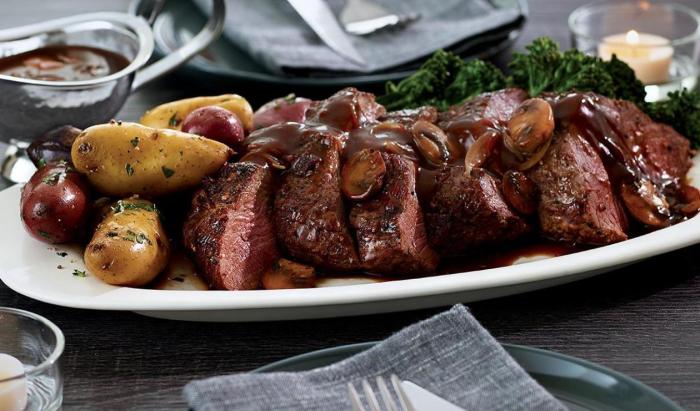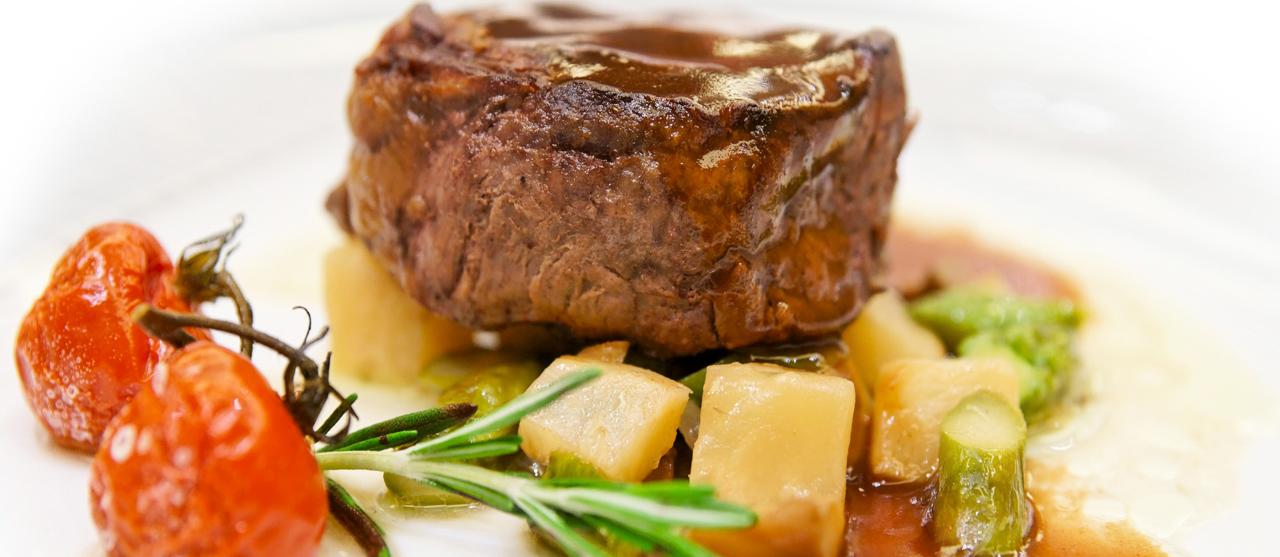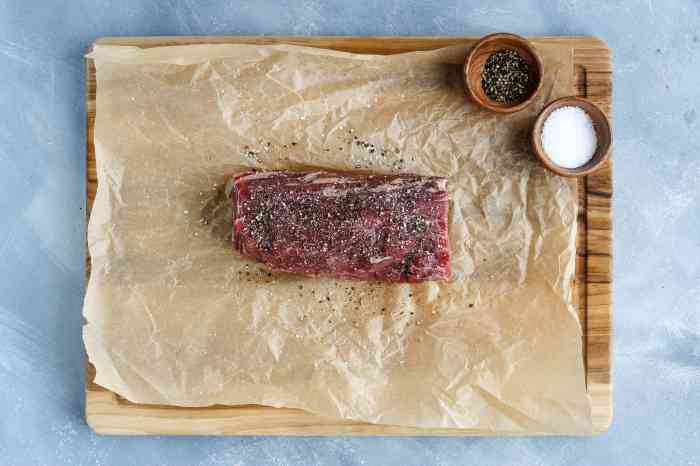Beef Chateaubriand Sauce Recipe A Culinary Guide
Chateaubriand: A Culinary Masterpiece: Beef Chateaubriand Sauce Recipe
Beef chateaubriand sauce recipe – The Chateaubriand, a luxurious cut of beef, holds a prestigious place in the culinary world. Its rich history, coupled with its exquisite flavor and tender texture, makes it a centerpiece for special occasions. This article delves into the preparation of this iconic dish, exploring its origins, classic and modern sauce variations, cooking techniques, plating styles, and ideal wine pairings.
Introduction to Chateaubriand

Source: unileversolutions.com
Named after the renowned French writer François-René de Chateaubriand, the steak itself isn’t directly linked to him, but rather popularized during a period when French cuisine flourished. The Chateaubriand is typically a center-cut portion of the tenderloin, boasting unparalleled tenderness and a rich, buttery flavor. It’s typically served as a substantial main course for two, ideal for romantic dinners or celebratory meals.
The ideal cut is a thick, cylindrical piece, typically around 2-3 inches thick and weighing between 1.5 to 2 pounds. The key characteristics are its exceptional tenderness, due to its location in the tenderloin, and its marbling, which contributes to its juicy and flavorful nature. Its relatively large size allows for even cooking and a beautiful sear.
Classic Chateaubriand Sauce Recipes

Source: tasteatlas.com
The Chateaubriand’s rich flavor is often complemented by a classic sauce, enhancing its inherent qualities. Below are three variations, each offering a unique flavor profile.
| Name | Ingredients | Instructions | Notes |
|---|---|---|---|
| Classic Béarnaise | Clarified butter, egg yolks, white wine vinegar, shallots, tarragon, peppercorns | Reduce vinegar with shallots and peppercorns. Whisk egg yolks and gradually incorporate the hot butter emulsion. Stir in tarragon. | Maintain a gentle simmer to prevent scrambling the eggs. |
| Red Wine Reduction | Red wine, beef broth, shallots, thyme, butter | Reduce red wine with shallots and thyme. Add beef broth and simmer until reduced and thickened. Stir in butter for richness. | Use a good quality dry red wine. |
| Mushroom Sauce | Butter, mushrooms, shallots, garlic, beef broth, heavy cream, thyme | Sauté shallots and garlic in butter. Add mushrooms and cook until softened. Deglaze with broth, add cream, and thyme, simmer until thickened. | Use a mix of mushroom varieties for depth of flavor. |
The role of each ingredient varies; butter adds richness, shallots and garlic provide savory depth, while herbs and wine contribute aromatic complexity. The reduction process concentrates flavors, creating a sauce that is both intense and elegant. Béarnaise offers a bright, tangy contrast, while the red wine reduction provides earthy notes, and the mushroom sauce brings an umami richness.
Modern Variations of Chateaubriand Sauce
Modern interpretations of Chateaubriand sauce explore unexpected flavor combinations, adding a contemporary twist to a classic dish.
- Truffle-Parmesan Sauce: Truffle oil, grated Parmesan cheese, heavy cream, white wine, thyme.
- Balsamic-Fig Sauce: Balsamic glaze, fresh figs (chopped), red wine vinegar, shallots, Dijon mustard.
- Spicy Chipotle-Lime Sauce: Chipotle peppers in adobo sauce, lime juice, cilantro, olive oil, honey.
The truffle-Parmesan sauce pairs beautifully with the richness of the Chateaubriand, adding earthy and nutty notes. The balsamic-fig sauce offers a sweet and tangy contrast, cutting through the richness of the beef. The spicy chipotle-lime sauce provides a vibrant, smoky heat that balances the richness of the steak. Challenges in creating these variations might include achieving the right balance of flavors and maintaining a smooth, consistent texture.
Cooking Techniques for Chateaubriand and Sauce
Achieving the perfect Chateaubriand requires precise cooking techniques. The steak should be seared to create a beautiful crust while maintaining a tender, juicy interior.
Searing: Pat the steak dry, season generously with salt and pepper. Heat a heavy-bottomed pan over high heat with a high smoke point oil (e.g., grapeseed or canola). Sear the steak for 2-3 minutes per side to develop a deep brown crust. Reduce heat and continue cooking to desired doneness, using a meat thermometer for accuracy.
Sauce preparation requires careful timing and temperature control to avoid scorching or curdling. For reductions, low and slow simmering is key to concentrate flavors. Emulsions, like Béarnaise, require gentle whisking and a steady stream of hot melted butter.
Consistency is achieved through proper reduction and the addition of thickening agents (if needed). The steak’s texture is determined by cooking time and temperature, with a meat thermometer ensuring perfect doneness.
Plating and Presentation, Beef chateaubriand sauce recipe
Elegant plating enhances the dining experience. Follow these steps for a sophisticated presentation:
- Slice the Chateaubriand against the grain into ½-inch thick slices.
- Arrange the slices on a preheated plate, slightly overlapping.
- Spoon the sauce generously over the steak slices.
- Garnish with fresh herbs (e.g., parsley, thyme).
Three plating styles include: a classic, linear arrangement; a fanned arrangement; and a more rustic, overlapping arrangement. Visual representations might include: a rich brown steak contrasted by the vibrant green of herbs and the deep red of a red wine reduction; a creamy white sauce offset by the dark brown of the seared steak and the bright green of asparagus; a rustic arrangement with earthy mushroom sauce, contrasting the dark beef with light, creamy elements.
Wine Pairing Suggestions

Source: thespruceeats.com
Several wine varietals complement the Chateaubriand and its accompanying sauce.
A full-bodied Cabernet Sauvignon provides robust tannins that cut through the richness of the beef, while its black fruit notes harmonize with the savory flavors of the sauce. A Merlot offers softer tannins and a more approachable style, while still complementing the richness of the meat. A Burgundy (Pinot Noir) provides a lighter, more elegant pairing, with earthy notes that complement the mushroom or Béarnaise sauce.
A classic beef chateaubriand sauce recipe often relies on rich, reduced pan juices. For a contrasting flavor profile, consider incorporating elements from other cuisines; you might find inspiration in the vibrant and zesty flavors of baja sauce recipes , perhaps adapting their bright citrus notes to complement the richness of the beef. Ultimately, your chateaubriand sauce will benefit from your creative exploration of diverse flavor combinations.
The choice of wine significantly impacts the dining experience. A well-chosen wine enhances the flavors of the dish, creating a harmonious and memorable culinary journey.
FAQ
Can I make the sauce ahead of time?
Yes, many Chateaubriand sauces can be made a day or two in advance. Store them properly refrigerated and reheat gently before serving.
What if my Chateaubriand is overcooked?
While aiming for a perfect sear and internal temperature is crucial, slight overcooking can be mitigated by using a rich sauce to add moisture and flavor.
What are some vegetarian alternatives to Chateaubriand?
While Chateaubriand is inherently a meat dish, you could adapt the sauce to complement a hearty vegetarian main course like a well-seared portobello mushroom or a flavorful vegetable wellington.





















